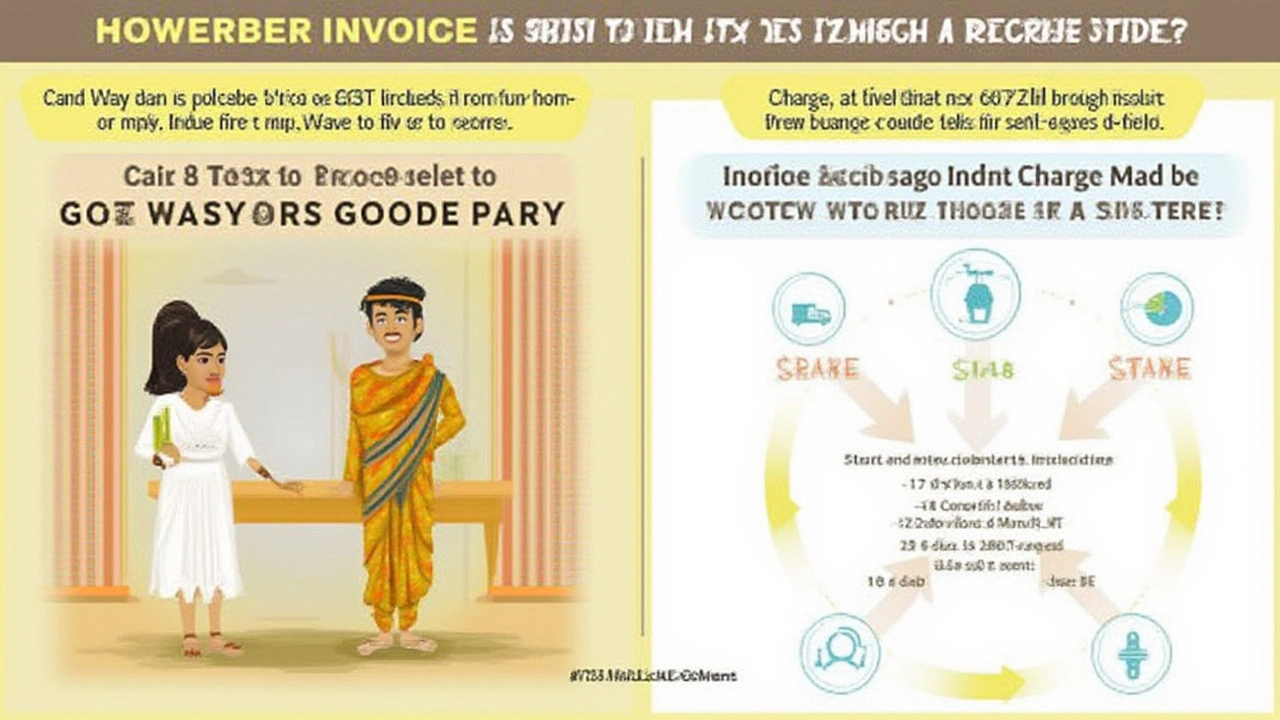Imagine buying headphones online late at night. You pay the final amount, and somewhere in the invoice, you spot a line saying GST included. But who's really footing that bill? Is it you, as the buyer, or is the seller pulling the strings behind the scenes? There's a surprising amount of confusion around who pays Goods and Services Tax (GST) in India. It's not helped by all the invoice details and technical terms that pop up on every receipt. If you've ever wondered whether you're the one dropping those rupees to government coffers or if it's the business you buy from, you're definitely not alone. Turns out, the answer is a bit more interesting than a simple yes or no, and it's got real implications whether you’re running a shop, freelancing, or just shopping online. Let’s shine a light on how things really work, bust some myths, and share tips so you never get thrown off by that GST line again.
How Does GST Work Behind the Scenes?
GST, or Goods and Services Tax, wasn’t just dropped into India’s economy for fun. It replaced a jungle of older taxes like VAT, service tax, excise, and a list too long to print on a phone screen. Here’s why that matters: it streamlined the process, made tax collection more transparent, and aimed to kill off cascading taxes where people and businesses got taxed on already-taxed goods.
The big principle of GST is that it’s an indirect tax. That means it’s collected from the buyer by the seller, but the seller doesn’t pocket that money—a chunk goes straight to the government, like a tax relay race. So, when you buy something, you pay the price + GST at checkout. The seller is responsible for collecting that GST and then handing it over to the tax department.
It sounds simple in theory, but real life brings a few layers. Sellers need to register for GST if their annual turnover blows past Rs 40 lakh for goods or Rs 20 lakh for services (there are special rates for some states). The moment they’re on the GST radar, they have to start collecting the right percentage on each bill, which ranges from 0% (on stuff like fresh veggies) to a whopping 28% (on fancy cars and luxury appliances). Each slab affects different sectors and products, so what you pay as GST depends a lot on what’s in your shopping cart.
Now, for the interesting stuff: sellers don’t always bear the cost themselves. They use something called input tax credit (ITC). If a shopkeeper buys a product from a wholesaler and pays GST on it, he gets credit for the tax he already paid when he sells that same product to you. So, the real weight of GST keeps shifting along the supply chain until the end customer—yup, that’s usually you—who ends up holding the tax bag. Even though it may look like the seller “pays” GST to the government, it’s actually the buyers, in the end, putting up the cash.
In short, both buyer and seller play a part, but the government gets the money from the seller, who collected it from you. That’s one reason businesses keep such detailed tax records—to make sure they’re claiming only their fair share of ITC and staying out of trouble with tax officials. No one wants to mess up those GST returns; the fines and headaches are real.
What Happens in Special Cases: Reverse Charge and E-Commerce?
Here’s where GST gets a bit spicy—there are some situations where the normal rules flip. Ever heard of reverse charge? Normally, the seller collects GST, but under reverse charge, the buyer is the one coughing up the tax straight to the government. It sounds rare, but in sectors like transport, certain government contracts, and situations dealing with unregistered suppliers, reverse charge is the rule.
Let’s say a big hotel chain hires a small logistics company that's not registered for GST. The hotel pays for the service and directly pays the GST to the government, rather than the logistics firm collecting it. This rule is meant to keep everyone honest and make sure GST keeps flowing even when small, unregistered outfits are involved. The government keeps a list of situations where reverse charge kicks in, so companies aren’t scratching their heads or waiting for tax officers to show up and explain things the hard way.
Switch gears to online shopping. When you buy from a marketplace like Amazon, there are more layers. The marketplace itself might collect GST on behalf of the seller for certain products or services (think hotel bookings, cab rides, or specific digital services). There’s even tax collected at source (TCS), where platforms deduct a small percentage of the total sales value before passing the money to sellers. This makes online transactions extra trackable—and it helps the government keep tabs on e-commerce, which has exploded in India over the last five years.
The bottom line is that whether you’re the buyer or the seller, sometimes you just can’t escape paying or collecting GST. The good news? These rules are mostly black-and-white, and the government regularly updates lists to cover new business models. Still, knowing the exceptions is smart business sense, especially if you’re starting something new or selling online.

Clearing Up Common GST Myths and Misconceptions
If you’ve chatted with anyone about GST, you’ve definitely heard a few wild stories. Some folks think GST is double-charged, while others assume small businesses don’t have to worry at all. There’s even that cousin who’s sure that sellers keep the GST money for themselves. Let’s set things straight with the facts and stamp out the confusion.
The most common myth is that sellers pay GST out of their own pockets. Not true. The buyer pays GST when purchasing goods or services. The seller is just a collector—imagine them as a go-between who passes on your GST to the government, not some greedy middleman.
Here’s another: Some believe, wrongly, that GST makes goods more expensive for everyone. While prices may have gone up for certain luxury products, daily essentials often got cheaper after old taxes were scrapped. Sure, those price stickers might shock you sometimes, but GST eliminated taxes like octroi, entry tax, and lots of other hidden charges. For many businesses, the tax routine actually got easier, though the paperwork is still no walk in the park.
Plenty of small shops worry they have to charge GST even if they’re under the threshold. The rule is clear: If your turnover is below Rs 40 lakh (for goods) or Rs 20 lakh (for services), you don’t register for GST. But once you cross that line—or want to claim input tax credits—you have to sign up, start collecting GST, and file returns every month.
Then there’s the confusion about input tax credit. Some people think it’s just for big companies, but even a freelancer buying software or a café buying coffee beans can use ITC to bring down their own GST burden. As long as you’re registered, and your vendor is too, you can claim that credit. Just remember—paperwork matters. Missing invoices or buying from unregistered folks can mean losing out on those savings.
And let’s not forget about the reverse charge. One rumor says only giant enterprises worry about it. In reality, any registered business that deals with an unregistered supplier in certain cases could face reverse charge. It pays to read the fine print and check government circulars every year—rules sometimes change without much warning.
Tips for Buyers and Sellers to Handle GST Smoothly
Navigating GST doesn’t mean memorizing a phonebook-sized manual. There are some straightforward ways to keep things simple, avoid mistakes, and even save cash if you play your cards right.
- GST in India always shows up as a separate line on your invoice—double-check this if you're a buyer. If it’s missing, you might be dealing with an unregistered seller or, worse, someone dodging tax.
- As a seller, register for GST as soon as your turnover even flirts with the threshold. Getting caught unregistered is a headache and leads to steep penalties.
- Keep all invoices neatly filed, both for your purchases and your sales. It’s your golden ticket to input tax credits and painless audits.
- Claim your input tax credit every month, but only when you have matching GSTINs and those details show up on the government’s GST portal. Mismatches mean rejections or delays in refunds.
- If you’re a buyer, don’t be shy to ask for a GST invoice. It protects your rights and helps if you need to claim ITC.
- For businesses: beware of the reverse charge cases and update your accounts when new rules drop. Regularly scan GST council updates—they decide everything from rates to exceptions.
- If you sell on platforms like Flipkart or Amazon, learn how Tax Collected at Source (TCS) affects your cash flow and GST returns. E-commerce sellers have extra paperwork, but most sites offer guides and calculators to help you stay on top.
- Watch out for deadlines. GST returns are usually monthly and one annual summary. Missing them can freeze your ITC and rack up late fees fast.
- Make use of accounting software or mobile apps geared for GST compliance. Many now plug directly into GSTN, reducing manual entry and mistakes.
- Don’t ignore small mistakes—rectify invoice typos, wrong rates, or mismatched GSTINs before the next return. It’s easier to fix early than after tax notices land in your inbox.
Ultimately, whether you’re buying, selling, or running an e-commerce store, GST’s impact on your wallet depends on how sharp you are with the details. Understand where GST sits in each transaction—are you the buyer, the seller, or both? Knowing this can help you stay compliant, cut down tax payouts, and skip nasty surprises. Next time you see that GST line, you'll know exactly who’s footing the bill—and why.


